9 protein-packed treats for your chooks
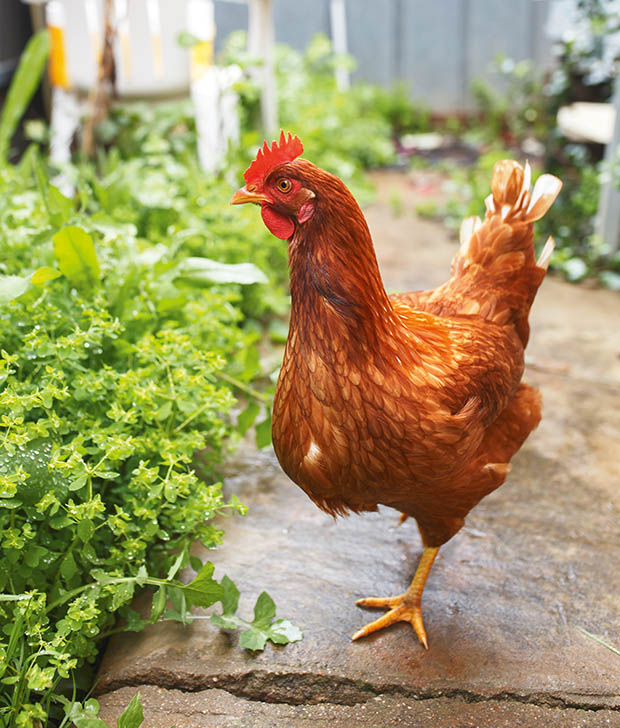
Poultry need specific amino acids in protein to be healthy. Here are nine easy ways to enrich their diet.
Words: Nadene Hall
Poultry have unique requirements from the protein they eat. Different types of protein are made up of amino acids in different concentrations, and poultry – particularly breeds that lay high numbers of eggs – need specific ones for good health.
Chickens are omnivores: that is, they eat both animals and vegetables, and they can obtain protein from both. However, two essential amino acids are only found in nutritious levels in animal products such as meat:
• lysine (lie-seen), crucial to muscle development;
• methionine (meh-thigh-oh-neen), essential for a large number of metabolic processes.
Both help birds develop a strong immune system. They’re also linked: methionine influences how well a bird can utilise lysine in its diet.
In most commercial feed, manufacturers add synthetic versions of both at the level required for good health.
The ‘building blocks’ of plant protein and meat protein are quite different. There isn’t enough lysine or methionine present even in high protein plants to fulfil a bird’s daily requirement – they couldn’t physically digest the amount of plant material required.
However, if your birds are free-ranging, there are higher protein plants and insects you can grow that will help contribute to their daily needs. It’s particularly beneficial to add these feeds if you’re using a certified organic feed as they’re often lower in lysine and methionine than synthetically-supplemented products.
DUCKWEED
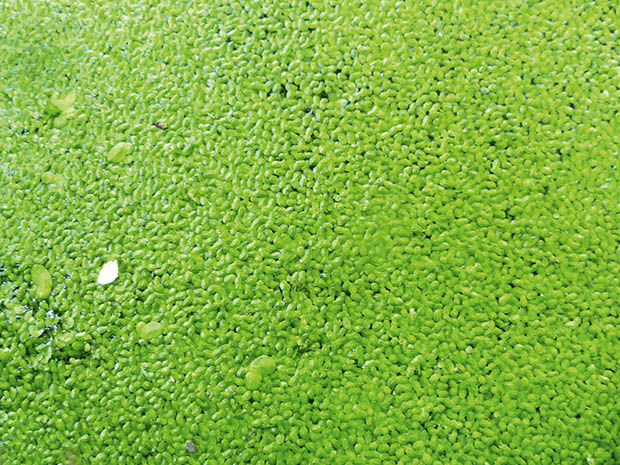
Protein: 20-40% under ideal growing conditions, often lower if growing in low-nutrient water
Fibre: 15-30%
Methionine: 0.9%
Lysine: 4%
How much to feed: up to 25% of dry matter per day
Where to find it: pet stores that sell fish, in waterways (make sure you identify it correctly and get permission to take it).
There are quite a few types of duckweed around the world. In NZ, there’s native duckweed (Lemna minor), and several introduced species.
Duckweed has tiny leaves (3mm-4mm) and free-floats on ponds, lakes, marshes, and slow-flowing water in creeks, forming a solid cover.
It’s made up almost entirely of metabolically active tissue, with very little fibre (less than 5% of its biomass) as it doesn’t require a stem structure to hold it up (because it floats). That’s much less than other high-protein plants such as soya where 50% of its biomass is fibre.
Every part of the plant can absorb nutrients (normally, this is limited to the roots).
Duckweed tissue contains twice the protein, fat, nitrogen, and phosphorus of other vascular plants (plants that circulate fluids like sap). The protein contains a better array of essential amino acids than most vegetable proteins and more closely resembles animal protein.
Growing conditions: it will grow in full sunlight right through to dense shade, and it’s very hardy, tolerating water temperatures down to 7°C. It goes dormant if water freezes and then re-emerges when warmer conditions return. It doesn’t like wavy water so a growing area needs to be sheltered.
It’s also important to have a cover over the growing area to keep the pH level down (6.0-7.0 is ideal) which also helps prevent algae.
Fertiliser: a great place to grow duckweed is in the run-off from a dairy shed or pig or poultry farm as it loves high nitrogen levels. Another option is to collect animal manure, put it in anaerobic water for a few days (in a drum, for example) and then mix or spray that into irrigation water. This assumes you grow duckweed in a pond or a container where fertilising the water will not contaminate a waterway.
Propagation: Experts describe the best method as ‘benign neglect’ and regular harvesting. Duckweeds can double their mass in 16-48 hours under optimal nutrient availability, sunlight, and water temperature.
How to harvest it: easily harvested using a skimmer (like you’d use to clean leaves out of a pool). Feed it fresh for optimal nutrition, but you can also store it by drying it out. Anything your hens don’t eat can be put into your compost or fed out to pigs, horses, and ruminants (sheep, cattle, goats).
Duckweed loves sucking up nitrogen and phosphates, so it has great potential for cleaning up contaminated waterways too.
Warning: young birds (those under 10 weeks) can’t absorb nutrients in duckweed very well so don’t feed it to them – use a different source of protein. If you’re planning to eat duckweed yourself (see page 57), it needs to be grown in safe, sanitary conditions.
4 things to know about duckweed
• Duckweed is the world’s fastest-growing plant, and has the smallest flower of any plant.
• At Rutgers University’s duckweed research unit, they can grow about five times the amount of duckweed per acre compared to maize. They believe they can get better growth once they perfect lighting, nutrients, and water temperature.
• Most research on duckweed as a superfood for humans uses a commercially cultivated strain of Wolffia globose called Mankai – it’s not yet available in NZ. However, NZ native duckweed (Lemna minor) seems to have similar growth and nutritional values, with protein levels from 20-40%.
• People should only eat duckweed grown in sanitary, hydroponic or controlled conditions. In the wild, it prefers to grow in still, high-nitrogen water and tends to accumulate heavy metals. Some varieties may also be high in oxalic acid (2-4% vs 0.5-1% for vegetables such as spinach and chard). The levels can be minimised by growing duckweed in ‘soft’ (low calcium) water, and researchers are working on growing varieties that are naturally lower in oxalates.
Why you should be eating duckweed too
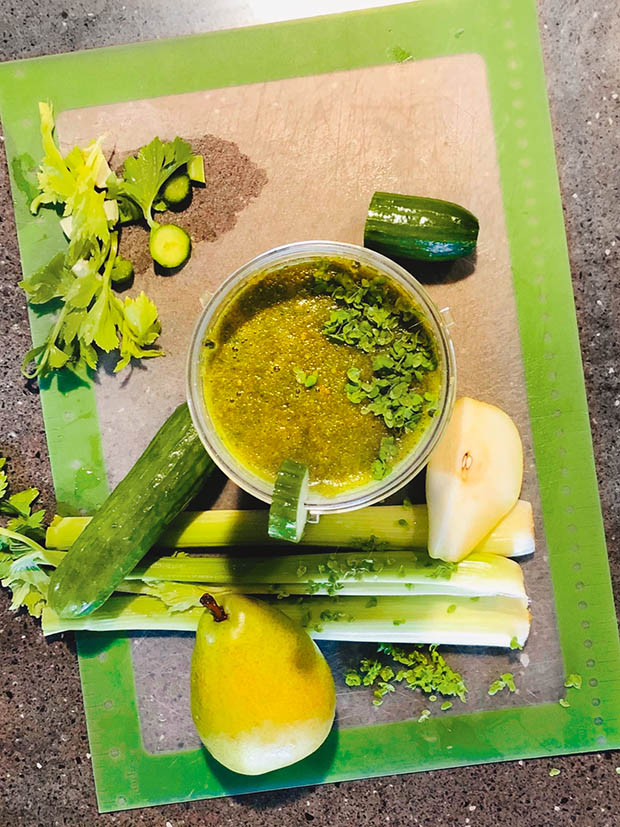
A smoothie made from a blend of pear, cucumber, celery, and duckweed.
Duckweed is a highly nutritious, mild-tasting plant you can add to salads, smoothies, and other dishes.
There are dozens of strains around the world, and most have protein levels of 30-40% by dry weight.
It’s also easy to grow and harvest.
Professor Eric Lam leads a team at Rutgers University, which has the world’s largest collection of duckweed species and their strains.
“Everyone in my lab, as well as visitors, has eaten it,” he says. “You can mix it with cottage cheese on a cracker or you can put it on your ramen noodles to add protein. I’ve eaten it with hamburgers and sandwiches.”
It’s easy to grow duckweed at home, and you can build your own growing set-up, says Professor Lam.
“Our working model is a very simple system with connected trays that rely on gravity for water flow. You skim duckweed from the water, rinse it and put it in your refrigerator, where it can be good for up to three months without preservatives.”
MEALWORMS
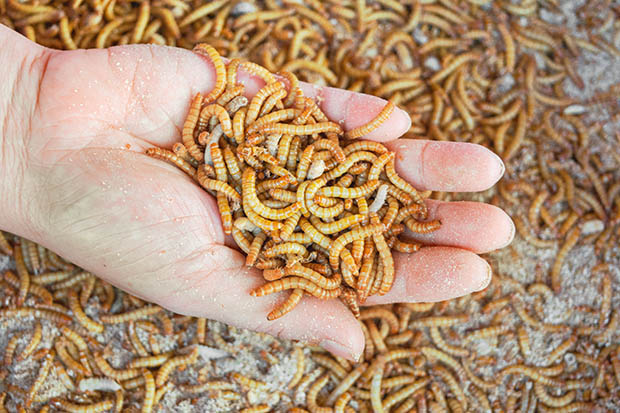
These creepy crawlies are easy to grow and make a great scratch feed.
Protein: 20%
Fibre: 1.7%
Fat: 12%
Methionine: 0.82%
Lysine: 2.8%
How much to feed out: these aren’t a replacement as a main feed ingredient for poultry as mealworms are too high in fat and protein and too low in methionine. They are a good quality supplemental scratch feed at the end of the day, around 10-20g per bird.
How to grow mealworms
You can buy packets of freeze-dried mealworms to feed tropical fish or reptiles, but you can grow them yourself if you don’t mind dealing with creepy crawlies.
It’s a fairly hands-off process once it’s set up. To make a growing unit:
• use large, clear plastic containers (at least 30cm wide x 30cm x 15cm high) with lids.
• drill 30-40 holes (5-7mm) into the lid and sides – there should be no condensation build-up so drill more holes if this occurs – or cover the top with fine wire mesh.
• cover the bottom with a 7-10cm layer of oat bran, or you can use Chick Starter.
• cut an apple in half and place it skin-side down, level with the feed. This allows the mealworms to get the moisture they require but doesn’t spoil the feed by wetting it.
• add mealworms – you can buy these online or at pet stores that specialise in fish. You want to start with around 30 mealworms per 30cm x 30cm of space in a container.
• cover the mealworms with four sheets of paper (plain, not newspaper or anything with print on it) and record the date on top. Put in a warm place (room temperature or warmer). Check the apples every week and replace if they’re starting to spoil or have been eaten. Add more as the mealworms get bigger.
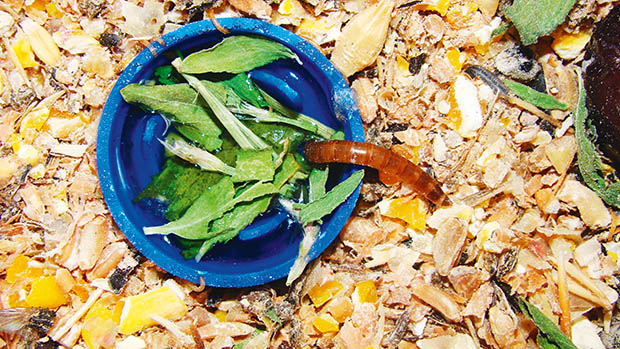
You want them to complete a lifecycle (8-12 weeks) so the pupa hatch and turn into beetles. They will then mate within the sheets of paper, lay their eggs and die. Their young will then populate the bran/feed mix, and the apples will need checking more often.
You should end up with hundreds of worms. Once they’re grown, put them into another container with a little bit of oat bran and some apple and store in a cool place – this can delay them turning into beetles for up to six months. Once a week, move the container into a warm place (room temperature) so they can warm up and have time to feed.
Tips
• Mealworms can grow quite quickly over summer and quite slowly over winter, so you may need to have more containers of worms going through their life cycle as you go into winter (when other protein sources are in low supply).
• Mealworms need watery foods such as fruit and vegetables as they use them as their main water source.
BLACK FLY LARVAE
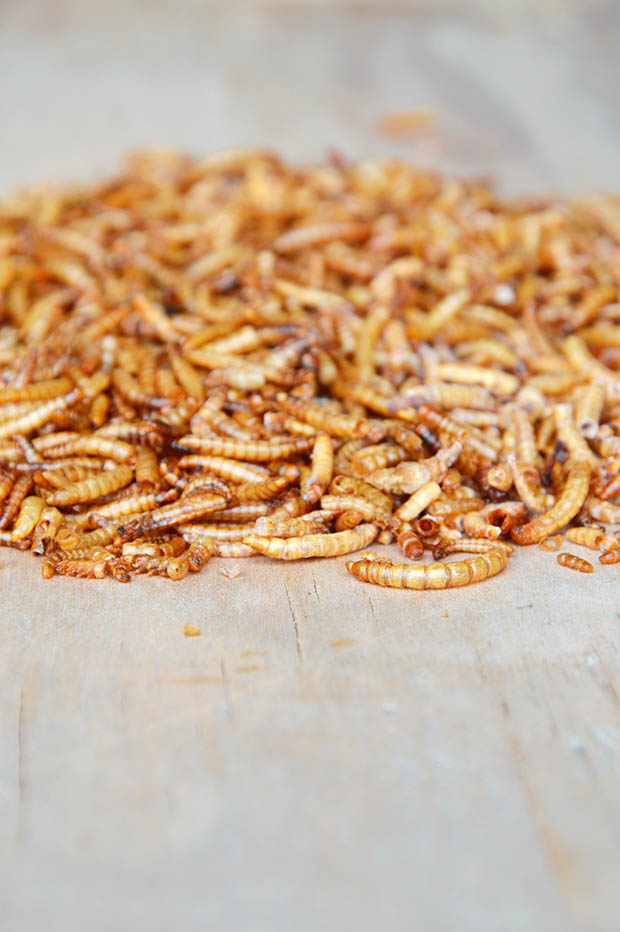
High protein, easy-to-grow, and they help get rid of houseflies.
Protein: 37%
Don’t get grossed out. Growing BSF larvae for your chickens requires no hands-on work at all dealing with maggots and no rotten smells. They’re a great supplement feed but are too low in methionine and lysine to be a big part of the diet.
Unlike other fly species, BSF larvae don’t carry disease and like aerobic conditions, so they’re unlikely to have botulism. You also don’t need to hold your breath every time you harvest larvae (or feed them).
The soldier fly is a fantastic composter of almost everything except bone and eggshell, reducing its volume by 95%. Its larvae are a great high protein feed for poultry, and the medium they grow in can then be fed to a worm farm to produce superior castings for your garden.
Black soldier flies are common in NZ in northern regions. They’re particularly attracted to grains and prefer partly-broken down feed rather than fresh.
They aren’t pests like houseflies either. They tend to avoid human habitats, don’t spread disease, sting or bite. They also dominate other fly species, reducing pest fly numbers such as houseflies.
6 other easy options
High-protein treats that your hens will love.
1. Meat & bone meal
Protein: 47%
Lysine: 2.6%
Methionine: 0.7%
This contains cooked bones, meat trimmings, and organs. Blood and bone meal has blood added, is also cooked, and has higher lysine levels (7%) but slightly lower methionine levels (0.6%).
2. Quinoa
Protein: 12-20%
Fat: 6%
Lysine: 5-6%
Methionine: 0.1-1%
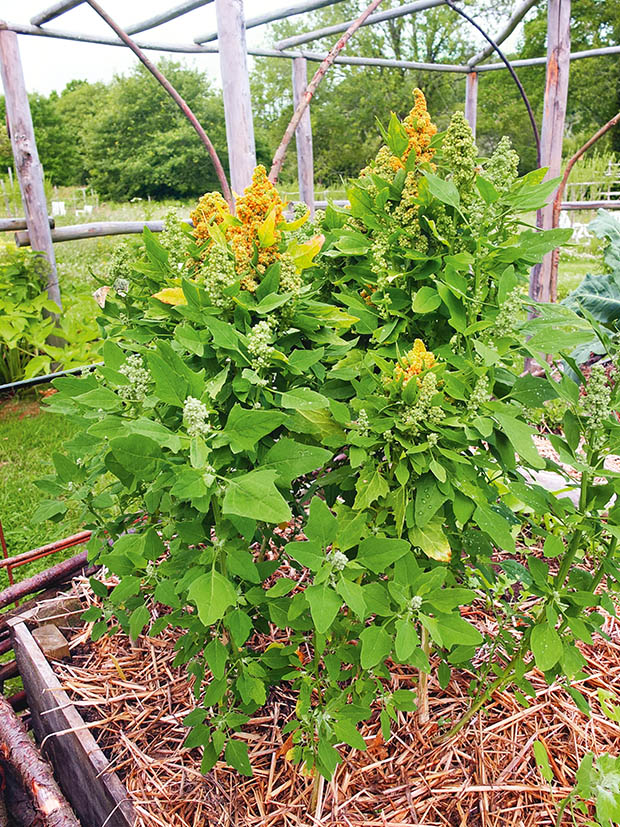
Quinoa.
Only a supplement to a balanced diet as it’s usually too low in methionine, and hard for hens to digest, but hens do love to eat it over many other options.
3. Sunflower meal
Protein: 32%
Fat: 1%
Lysine: 1.14% Methionine: 0.6%
Only a supplement as it’s too low in lysine, and also hard for hens to digest.
4. Earthworms
Protein: 60-70%
Fat: 6-11%
Lysine: 6.8%
Methionine: 2.0%
Research has found that two worms common in NZ are excellent sources of protein, methionine, and lysine.
Most earthworm species have very similar nutritional values, including the ‘tiger’ or red earthworm (Eisenia foetida, the one you find in vermicomposting systems), and the most widespread earthworm found in NZ soil, Lumbricus rubellus.
5. Garden snails & slugs
Protein: 15%+
Fat: 2.4%
Lysine: 4.35%
Methionine: 1%
Lean a length of wood against a garden bed. Snails will swarm to it to rest under it after feeding. Remove the board and place the snails in a pot. Boil for 15-20 minutes. Snails have good levels of available protein, methionine and lysine when cooked and can be fed at a rate of 15% of a bird’s daily diet (about 18-20g per adult 2kg bird).
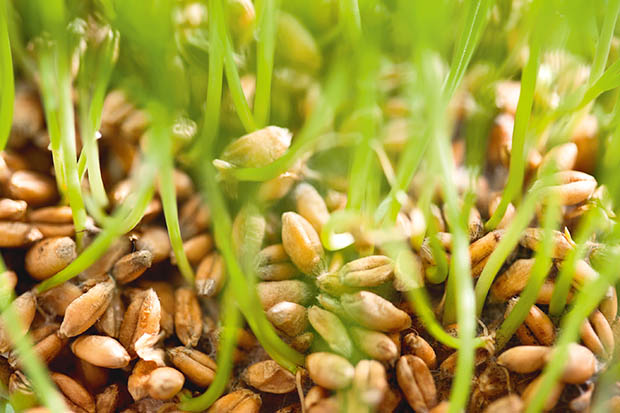
6. Sprouting grains
Research has found that sprouting grains increases the nutrient availability, digestibility, and growth of poultry. The chemical nature of sprouting appears to activate natural enzymes in grain which are higher in energy and easier on the chicken gut.
Warning: sprouting grains can go mouldy and/or become contaminated with harmful bacteria. Mist them frequently (at least once a day) with diluted cider vinegar (65ml to 1 litre
of water or 1¼ teaspoons to 100ml).
BONUS: Plantain is high in bioactive nutrient plant chemicals that may provide desirable health benefits beyond basic nutrition, reducing the risk of major chronic diseases.
Love this story? Subscribe now!
 This article first appeared in NZ Lifestyle Block Magazine.
This article first appeared in NZ Lifestyle Block Magazine.
